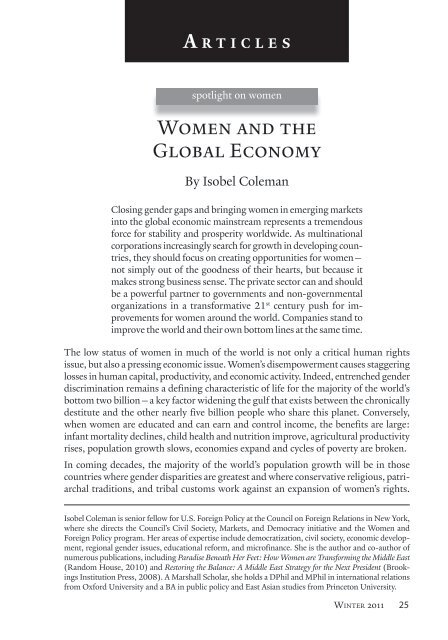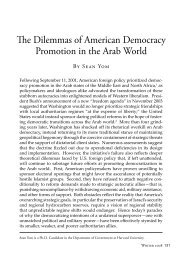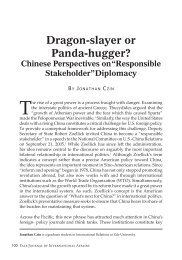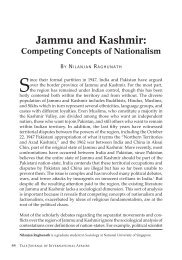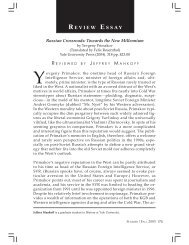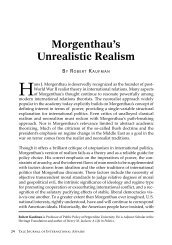Women and the Global Economy - Yale Journal of International Affairs
Women and the Global Economy - Yale Journal of International Affairs
Women and the Global Economy - Yale Journal of International Affairs
You also want an ePaper? Increase the reach of your titles
YUMPU automatically turns print PDFs into web optimized ePapers that Google loves.
A r t i c l e s<br />
spotlight on women<br />
<strong>Women</strong> <strong>and</strong> <strong>the</strong><br />
<strong>Global</strong> <strong>Economy</strong><br />
By Isobel Coleman<br />
Closing gender gaps <strong>and</strong> bringing women in emerging markets<br />
into <strong>the</strong> global economic mainstream represents a tremendous<br />
force for stability <strong>and</strong> prosperity worldwide. As multinational<br />
corporations increasingly search for growth in developing countries,<br />
<strong>the</strong>y should focus on creating opportunities for women—<br />
not simply out <strong>of</strong> <strong>the</strong> goodness <strong>of</strong> <strong>the</strong>ir hearts, but because it<br />
makes strong business sense. The private sector can <strong>and</strong> should<br />
be a powerful partner to governments <strong>and</strong> non-governmental<br />
organizations in a transformative 21 st century push for improvements<br />
for women around <strong>the</strong> world. Companies st<strong>and</strong> to<br />
improve <strong>the</strong> world <strong>and</strong> <strong>the</strong>ir own bottom lines at <strong>the</strong> same time.<br />
The low status <strong>of</strong> women in much <strong>of</strong> <strong>the</strong> world is not only a critical human rights<br />
issue, but also a pressing economic issue. <strong>Women</strong>’s disempowerment causes staggering<br />
losses in human capital, productivity, <strong>and</strong> economic activity. Indeed, entrenched gender<br />
discrimination remains a defining characteristic <strong>of</strong> life for <strong>the</strong> majority <strong>of</strong> <strong>the</strong> world’s<br />
bottom two billion—a key factor widening <strong>the</strong> gulf that exists between <strong>the</strong> chronically<br />
destitute <strong>and</strong> <strong>the</strong> o<strong>the</strong>r nearly five billion people who share this planet. Conversely,<br />
when women are educated <strong>and</strong> can earn <strong>and</strong> control income, <strong>the</strong> benefits are large:<br />
infant mortality declines, child health <strong>and</strong> nutrition improve, agricultural productivity<br />
rises, population growth slows, economies exp<strong>and</strong> <strong>and</strong> cycles <strong>of</strong> poverty are broken.<br />
In coming decades, <strong>the</strong> majority <strong>of</strong> <strong>the</strong> world’s population growth will be in those<br />
countries where gender disparities are greatest <strong>and</strong> where conservative religious, patriarchal<br />
traditions, <strong>and</strong> tribal customs work against an expansion <strong>of</strong> women’s rights.<br />
Isobel Coleman is senior fellow for U.S. Foreign Policy at <strong>the</strong> Council on Foreign Relations in New York,<br />
where she directs <strong>the</strong> Council’s Civil Society, Markets, <strong>and</strong> Democracy initiative <strong>and</strong> <strong>the</strong> <strong>Women</strong> <strong>and</strong><br />
Foreign Policy program. Her areas <strong>of</strong> expertise include democratization, civil society, economic development,<br />
regional gender issues, educational reform, <strong>and</strong> micr<strong>of</strong>inance. She is <strong>the</strong> author <strong>and</strong> co-author <strong>of</strong><br />
numerous publications, including Paradise Beneath Her Feet: How <strong>Women</strong> are Transforming <strong>the</strong> Middle East<br />
(R<strong>and</strong>om House, 2010) <strong>and</strong> Restoring <strong>the</strong> Balance: A Middle East Strategy for <strong>the</strong> Next President (Brookings<br />
Institution Press, 2008). A Marshall Scholar, she holds a DPhil <strong>and</strong> MPhil in international relations<br />
from Oxford University <strong>and</strong> a BA in public policy <strong>and</strong> East Asian studies from Princeton University.<br />
Winter 2011 25
ISOBEL COLEMAN<br />
As multinational companies increasingly search for growth in <strong>the</strong> developing world,<br />
<strong>the</strong>y should explicitly focus on breaking down barriers <strong>and</strong> creating opportunities for<br />
women—not simply out <strong>of</strong> <strong>the</strong> goodness <strong>of</strong> <strong>the</strong>ir hearts, but because it makes strong<br />
business sense. Just as corporations have found that “going green” can improve <strong>the</strong>ir<br />
bottom lines, companies that recognize women’s empowerment as critical for increasing<br />
labor-force productivity, improving <strong>the</strong> quality <strong>of</strong> <strong>the</strong>ir global supply chains <strong>and</strong><br />
exp<strong>and</strong>ing <strong>the</strong>ir customer base <strong>and</strong> distribution networks will enjoy a competitive<br />
advantage. With <strong>the</strong>ir influential br<strong>and</strong>s <strong>and</strong> promises <strong>of</strong> investment <strong>and</strong> employment,<br />
<strong>the</strong> private sector can be a powerful partner to<br />
Unleashing <strong>the</strong><br />
potential <strong>of</strong> women<br />
is an enormous<br />
opportunity for <strong>the</strong><br />
global economy, akin<br />
to stumbling upon a<br />
relatively untapped<br />
emerging market.<br />
26 <strong>Yale</strong> <strong>Journal</strong> <strong>of</strong> <strong>International</strong> <strong>Affairs</strong><br />
governments <strong>and</strong> non-governmental organizations<br />
in a transformative twenty-first century push for improvements<br />
for women.<br />
The Third Billion<br />
Unleashing <strong>the</strong> potential <strong>of</strong> women is an enormous<br />
opportunity for <strong>the</strong> global economy, akin to stumbling<br />
upon a relatively untapped emerging market. Indeed,<br />
a recent Booz & Company study suggests that underserved<br />
<strong>and</strong> disempowered women around <strong>the</strong> world<br />
represent <strong>the</strong> “third billion,” equivalent to <strong>the</strong> billionplus<br />
population markets <strong>of</strong> India <strong>and</strong> China. 1 Booz &<br />
Company estimates that over <strong>the</strong> next decade, as many<br />
as 870 million women could join <strong>the</strong> economic mainstream,<br />
with that figure possibly surpassing one billion by 2030. Yet, this potential<br />
will only be realized if women are better prepared in terms <strong>of</strong> education <strong>and</strong> are more<br />
enabled by <strong>the</strong>ir families <strong>and</strong> communities to participate in <strong>the</strong> global economy.<br />
The inclusion <strong>of</strong> previously disenfranchised women in <strong>the</strong> global economy could<br />
help drive growth in times <strong>of</strong> prosperity, <strong>and</strong> temper <strong>the</strong> negative effects <strong>of</strong> economic<br />
downturns. Booz & Company suggests that integrating <strong>the</strong> “third billion” could have<br />
an even greater global impact than <strong>the</strong> emergence <strong>of</strong> China <strong>and</strong> India because <strong>the</strong><br />
benefits <strong>of</strong> women’s empowerment would be spread widely ra<strong>the</strong>r than concentrated<br />
in single countries. 2 Companies that help speed <strong>the</strong> process <strong>of</strong> female empowerment<br />
<strong>and</strong> economic integration will realize <strong>the</strong> benefits.<br />
According to a 2009 McKinsey & Company study, however, less than 20 percent <strong>of</strong><br />
global companies surveyed—companies that are already engaged in emerging markets—<br />
are doing anything specifically focused on women. 3 More than half <strong>of</strong> <strong>the</strong> respondents<br />
admitted that <strong>the</strong>y simply had not considered making women’s empowerment a distinct<br />
strategic priority.<br />
Among those companies that are engaged in women’s economic empowerment<br />
initiatives in developing countries, nearly three quarters <strong>of</strong> respondents stated that<br />
<strong>the</strong>ir investments in women were already increasing <strong>the</strong>ir pr<strong>of</strong>its or <strong>the</strong>y expected <strong>the</strong>m<br />
to do so soon. 4 Some forward-looking companies are experimenting with different<br />
programs to support female employees in emerging markets—providing <strong>the</strong>m with<br />
training, education <strong>and</strong> mentoring, access to financial services, healthcare, <strong>and</strong> family
WOMEN AND THE GLOBAL ECONOMY<br />
planning. They are also incorporating women-owned businesses into <strong>the</strong>ir supply<br />
chains, tailoring products for women, <strong>and</strong> accessing new customers through female<br />
distribution models—<strong>and</strong> beginning to realize results.<br />
Doing Good <strong>and</strong> Doing Well<br />
Tupperware is one such company that is deploying its assets to improve <strong>the</strong> lives<br />
<strong>of</strong> women in emerging markets. Tupperware is <strong>the</strong> iconic American company that<br />
literally invented <strong>the</strong> party-based sales model—by women, for women—back in <strong>the</strong><br />
1950s when fewer than a third <strong>of</strong> American women worked outside <strong>the</strong> home. Today,<br />
Tupperware is replicating that model overseas, <strong>and</strong> driving social change in emerging<br />
markets around <strong>the</strong> world. Eighty-five percent <strong>of</strong> company revenue comes from outside<br />
<strong>the</strong> United States, <strong>and</strong> nearly 50 percent comes from emerging markets such as Egypt,<br />
India <strong>and</strong> Indonesia. In India alone, its all-female sales force numbers more than<br />
50,000, with new consultants able to make as much as teachers <strong>and</strong> nurses. 5 These<br />
Tupperware ladies provide critical income for <strong>the</strong>ir families, with many reporting that<br />
<strong>the</strong>ir earnings pay for school fees, better healthcare <strong>and</strong> improved nutrition for <strong>the</strong>ir<br />
children. As breadwinners, managers <strong>and</strong> trainers, Tupperware ladies enjoy greater<br />
self-confidence <strong>and</strong> stature <strong>and</strong> become leaders in <strong>the</strong>ir communities.<br />
St<strong>and</strong>ard Chartered Bank (SCB) is ano<strong>the</strong>r example <strong>of</strong> a company that underst<strong>and</strong>s<br />
<strong>the</strong> positive effect <strong>of</strong> women’s empowerment on economic development, <strong>and</strong> its own<br />
bottom line. A financial services company whose history is intertwined with <strong>the</strong><br />
British Empire, St<strong>and</strong>ard Chartered generates 90 percent <strong>of</strong> its income today from<br />
operations in seventy-one countries in Africa, <strong>the</strong> Middle East <strong>and</strong> Asia. In <strong>the</strong> last<br />
three years, it has provided $540 million <strong>of</strong> credit <strong>and</strong> financial instruments to sixtythree<br />
micr<strong>of</strong>inance institutions (MFIs) across Asia, <strong>the</strong> Middle East, <strong>and</strong> Africa. 6 It<br />
also focuses on agricultural finance due to <strong>the</strong> large growth potential <strong>and</strong> important<br />
development role agriculture plays in many countries where <strong>the</strong> bank operates. In<br />
addition, SCB is helping finance a shift toward a low-carbon economy, in accordance<br />
with a five-year clean technology <strong>and</strong> renewable energy commitment it made at <strong>the</strong><br />
2007 Clinton <strong>Global</strong> Initiative. 7 Although SCB does not explicitly state that <strong>the</strong>se<br />
measures have been adopted to empower women in developing countries, women are<br />
<strong>the</strong> group that st<strong>and</strong>s to benefit most from <strong>the</strong>m, as small businesses <strong>and</strong> agriculture<br />
are female-dominated sectors in many countries where SCB operates. Clean technology<br />
<strong>and</strong> renewable energy sources can help women avoid many <strong>of</strong> <strong>the</strong> health <strong>and</strong> o<strong>the</strong>r<br />
hazards associated with traditional methods <strong>of</strong> cooking, heating, <strong>and</strong> agriculture.<br />
In a fur<strong>the</strong>r move to differentiate itself, SCB some years ago decided to focus on women<br />
as customers <strong>and</strong> clients in markets where <strong>the</strong>y have traditionally been underserved.<br />
In December 2008, SCB launched a women’s empowerment program to enhance<br />
financial literacy, financial planning, investment <strong>and</strong> capacity building for women<br />
owners <strong>of</strong> small businesses, aiming to reach 5,000 women in Asia by 2011. 8 In India<br />
<strong>and</strong> Pakistan, <strong>the</strong> bank operates all-female branches; in Africa, it runs its “Diva Club,”<br />
a savings program that encourages women to save in groups <strong>and</strong> facilitates networking<br />
among female clients. SCB sees <strong>the</strong>se programs as valuable in building customer loyalty<br />
<strong>and</strong> creating a first-mover advantage for <strong>the</strong> bank. Along <strong>the</strong> way, <strong>the</strong>se initiatives also<br />
Winter 2011 27
ISOBEL COLEMAN<br />
bring underserved women into <strong>the</strong> financial mainstream, helping <strong>the</strong>m become savers<br />
for <strong>the</strong>ir families, exp<strong>and</strong> <strong>the</strong>ir decision-making <strong>and</strong> build <strong>the</strong>ir businesses through<br />
improved financial literacy <strong>and</strong> access to credit.<br />
O<strong>the</strong>r corporations are beginning to underst<strong>and</strong> <strong>the</strong> vast potential <strong>of</strong> <strong>the</strong> “third billion.”<br />
Walmart, for example, is rapidly exp<strong>and</strong>ing in emerging markets like India, Brazil,<br />
Mexico, <strong>and</strong> South Africa. Since 75 percent <strong>of</strong> its employees are women, it recognizes<br />
that it has a clear interest in promoting women’s economic empowerment in its new<br />
markets. Working alongside CARE, a humanitarian organization that combats global<br />
poverty, Walmart has launched several pilot programs to teach literacy <strong>and</strong> workplace<br />
skills in <strong>the</strong> developing world. In Peru, it is helping female farmers meet <strong>the</strong> company’s<br />
quality-control st<strong>and</strong>ards. In Bangladesh, it is training local women in <strong>the</strong> garment<br />
industry to move up from fabric sorters to seamstresses <strong>and</strong> cutters. Similarly, it is<br />
developing <strong>the</strong> skills <strong>of</strong> female cashew farmers in India so that <strong>the</strong>y can progress<br />
from low-level pickers to high-end processors. Walmart expects to see increased<br />
productivity, higher quality, <strong>and</strong> greater diversity in its supply chain as a result. Still,<br />
<strong>the</strong> potential to do more is huge. With more than $400 billion in revenues (more<br />
than <strong>the</strong> GDP <strong>of</strong> Norway), Walmart is <strong>the</strong> world’s largest retailer <strong>and</strong> its purchasing<br />
decisions have a cascading effect throughout <strong>the</strong> global supply chain. If it sourced just<br />
1 percent <strong>of</strong> its sales from women-owned businesses, this alone could channel billions<br />
<strong>of</strong> dollars toward women’s economic empowerment—far more than what international<br />
development agencies can muster for such efforts.<br />
Impetus for Change<br />
Given <strong>the</strong> cultural sensitivities surrounding <strong>the</strong> status <strong>of</strong> girls <strong>and</strong> women in many<br />
emerging markets, it is not surprising that multinational companies <strong>of</strong>ten approach<br />
<strong>the</strong> topic gingerly. The fact that <strong>the</strong> senior management <strong>of</strong> local subsidiaries is <strong>of</strong>ten<br />
overwhelmingly male, with strong patriarchal views <strong>the</strong>mselves, presents additional<br />
obstacles.<br />
Companies, however, are becoming increasingly proactive today with respect to<br />
women’s rights not only because <strong>the</strong>y see opportunity, but also partly in response to<br />
shareholder dem<strong>and</strong>s on social issues <strong>and</strong> in some cases, home-country diversity laws.<br />
The rise <strong>of</strong> female senior managers, board members <strong>and</strong> CEOs in Western companies<br />
can also put <strong>the</strong> issue higher on a corporation’s agenda. Michael Shtender-Auerbach, a<br />
consultant with Control Risks who advises multinational companies on various social<br />
risk factors, including gender issues, sees this as an increasingly important dynamic.<br />
“When corporations request social impact assessments prior to making overseas investments,<br />
women’s rights are rarely <strong>the</strong> primary concern, but <strong>the</strong>y are definitely getting<br />
more priority <strong>the</strong>se days,” he says. 9 With more than $2 trillion in socially responsible<br />
investment (SRI) funds, <strong>and</strong> women’s rights an increasingly high-pr<strong>of</strong>ile component<br />
<strong>of</strong> <strong>the</strong> social justice agenda that concerns SRI funds, that trend is likely to continue.<br />
Root Capital is one such social investment fund that encourages its portfolio companies<br />
to leverage <strong>the</strong> talents <strong>of</strong> women. While women’s empowerment is not its<br />
explicit social m<strong>and</strong>ate, it does so because, for business reasons, it wants to encourage<br />
inclusion <strong>of</strong> women among its clients. “We are more inclined to invest in companies<br />
28 <strong>Yale</strong> <strong>Journal</strong> <strong>of</strong> <strong>International</strong> <strong>Affairs</strong>
WOMEN AND THE GLOBAL ECONOMY<br />
that have figured out how to integrate women as employees <strong>and</strong> managers,” explains<br />
William Foote, Root Capital’s founder <strong>and</strong> CEO. “It is a sign that <strong>the</strong>y are seeking<br />
talent <strong>and</strong> opportunities.” 10 Root Capital’s mission is to provide capital <strong>and</strong> financial<br />
education to small <strong>and</strong> growing businesses in rural areas <strong>of</strong> developing countries.<br />
Approximately 20 percent <strong>of</strong> Root Capital’s investments are in women-led businesses,<br />
but <strong>the</strong> company sees real opportunity in influencing <strong>the</strong> o<strong>the</strong>r 80 percent <strong>of</strong><br />
its portfolio to think more carefully about how <strong>the</strong>y are integrating <strong>and</strong> promoting<br />
women. “We are considering <strong>of</strong>fering a discount<br />
on our loans—<strong>and</strong>/or providing financial management<br />
training alongside <strong>the</strong> credit—for companies<br />
that meet certain gender-balance criteria. This isn’t<br />
about social engineering—we see this as a good<br />
business practice that we want to encourage among<br />
our portfolio companies. We know it will pay <strong>of</strong>f for<br />
<strong>the</strong>m, <strong>and</strong> for us,” says Foote.<br />
Private-sector<br />
interventions… can<br />
play a significant role<br />
in breaking down<br />
barriers <strong>and</strong> changing<br />
deeply entrenched<br />
detrimental cultural<br />
practices for women.<br />
Private-sector interventions such as <strong>the</strong>se, if replicated<br />
across <strong>the</strong> global economy, can play a significant<br />
role in breaking down barriers <strong>and</strong> changing deeply<br />
entrenched detrimental cultural practices for women.<br />
In India, for example, <strong>the</strong> government has tried for<br />
decades to get parents to place more value in girls,<br />
but patriarchy dies hard. With <strong>the</strong> spread <strong>of</strong> low-cost<br />
sonogram technology across rural India, parents show <strong>the</strong>ir continuing preference for<br />
boys by illegally aborting unwanted girls. In some parts <strong>of</strong> <strong>the</strong> country, as many as 140<br />
boys are born for every one hundred girls. Some fascinating new studies, however,<br />
indicate that maybe <strong>the</strong> private sector can succeed in changing this pernicious dynamic<br />
more effectively than government policy. Pr<strong>of</strong>essor Robert Jensen <strong>of</strong> UCLA’s School <strong>of</strong><br />
Public <strong>Affairs</strong> conducted a study providing three years <strong>of</strong> recruiting services to young<br />
girls in r<strong>and</strong>omly selected Indian villages to help <strong>the</strong>m get jobs in <strong>the</strong> business process<br />
outsourcing industry. At <strong>the</strong> end <strong>of</strong> <strong>the</strong> study, girls in <strong>the</strong> selected villages were more<br />
likely to be in school <strong>and</strong> had greater measured body mass index (BMI) than girls in<br />
control villages (an indication <strong>of</strong> improved caloric consumption). Paid employment<br />
was also 2.4 percent higher for women aged 18–24. 11 According to Jensen’s research,<br />
this small, low-cost intervention not only contributed to raising girls’ education <strong>and</strong><br />
health, but even weakened couples’ strong preference to give birth to sons. As <strong>the</strong><br />
private sector exp<strong>and</strong>s economic opportunities for women in India, girls’ value to<br />
<strong>the</strong>ir families will grow <strong>and</strong> more parents should welcome <strong>the</strong> birth <strong>of</strong> a daughter.<br />
General Electric (GE) is a company with a significant stake in seeing <strong>the</strong> attitudes <strong>of</strong><br />
parents in India become more favorable to girls. GE makes <strong>the</strong> sonogram technology<br />
that is widely used for sex-selective abortion in <strong>the</strong> country, although that practice<br />
has been illegal since 1994. To fur<strong>the</strong>r deter <strong>the</strong> widespread practice, <strong>the</strong> Indian<br />
government passed a law in 2002 holding <strong>the</strong> manufacturers <strong>and</strong> distributors <strong>of</strong><br />
sonogram equipment responsible for preventing female feticide. GE’s response was<br />
to create a series <strong>of</strong> training programs, sales-screening procedures, <strong>and</strong> post-sale<br />
Winter 2011 29
ISOBEL COLEMAN<br />
auditing processes designed to detect misuse, <strong>and</strong> it also puts warning labels on its<br />
equipment. None<strong>the</strong>less, abortion providers continue to flout <strong>the</strong> law. With Indian<br />
activists accusing GE <strong>of</strong> being complicit in female feticide, <strong>the</strong> company recognized<br />
that it had more than just a public relations problem on its h<strong>and</strong>s. If it hoped to<br />
continue to dominate India’s ultrasound market, it would have to confront <strong>the</strong> low<br />
status <strong>of</strong> women in Indian society. In recent years, it has met with activist groups<br />
<strong>and</strong> launched a poster campaign to change attitudes about women’s rights. It has also<br />
begun to fund education for girls <strong>and</strong> sponsor progressive role models, including a<br />
hip, young tennis star. Ingrained cultural attitudes <strong>of</strong> course do not change overnight,<br />
but <strong>the</strong> private sector has an important role to play in revaluing <strong>the</strong> life <strong>of</strong> girls in<br />
traditional societies.<br />
Getting Serious<br />
For companies operating in emerging markets that are just now considering women’s<br />
empowerment as a core business objective, here are five principles that can help guide<br />
a strategy:<br />
First, define <strong>and</strong> measure success appropriately. Obstacles to female empowerment<br />
differ across regions, so companies must identify <strong>the</strong> relevant issues in each market.<br />
For example, do female employees need a male family member’s permission to work<br />
Do <strong>the</strong>y have transportation <strong>and</strong> safety constraints different from men Do <strong>the</strong>y have<br />
access to financial services so that <strong>the</strong>y can actually control <strong>the</strong>ir incomes Do <strong>the</strong>y<br />
have identity cards that allow <strong>the</strong>m to be counted as citizens Is family planning <strong>and</strong><br />
maternal health care available, so women can choose <strong>the</strong> number <strong>and</strong> timing <strong>of</strong> <strong>the</strong>ir<br />
children <strong>and</strong> deliver <strong>the</strong>m safely Are <strong>the</strong>y able to send <strong>the</strong>ir girls <strong>and</strong> boys to school<br />
at equal rates It is critical that companies underst<strong>and</strong> <strong>the</strong> context <strong>of</strong> gender issues in<br />
<strong>the</strong> markets in which <strong>the</strong>y operate.<br />
Second, although donating money to women’s initiatives is a good start, incorporating<br />
<strong>the</strong> goal <strong>of</strong> women’s empowerment into actual business practices is even better.<br />
Bringing female farmers into <strong>the</strong> global supply chain presents a significant economic<br />
opportunity for women: in sub-Saharan Africa <strong>and</strong> South Asia, farm labor is more<br />
than 70 percent female, yet women tend to focus on subsistence crops ra<strong>the</strong>r than<br />
cash crops, a sector still dominated by men. Developing women to create new sales<br />
force capacity <strong>and</strong> distribution models also holds great potential, as <strong>the</strong> experience <strong>of</strong><br />
Tupperware shows. Even sectors that employ a low percentage <strong>of</strong> women, such as <strong>the</strong><br />
extractive industries, could encourage women-owned businesses in support service<br />
areas, such as catering, laundry, <strong>of</strong>fice cleaning, <strong>and</strong> transportation.<br />
Third, companies should concentrate on providing skills <strong>and</strong> resources to female<br />
entrepreneurs <strong>and</strong> business leaders. This could mean exp<strong>and</strong>ing financial services to<br />
female clients—not just credit but savings products, too—as St<strong>and</strong>ard Chartered Bank<br />
has done. Or it could take <strong>the</strong> form <strong>of</strong> supporting an existing local organization that<br />
helps women obtain access to health care, identity cards, or property rights. Leadership<br />
training, as well as secondary <strong>and</strong> university education, is central to developing <strong>the</strong><br />
next generation <strong>of</strong> female business leaders <strong>and</strong> managers.<br />
30 <strong>Yale</strong> <strong>Journal</strong> <strong>of</strong> <strong>International</strong> <strong>Affairs</strong>
WOMEN AND THE GLOBAL ECONOMY<br />
Fourth, companies should not shy away from taking on thorny issues. Although<br />
corporations underst<strong>and</strong>ably resist being associated with controversy, <strong>the</strong>y do have an<br />
interest in engaging in sensitive topics such as child marriage <strong>and</strong> women’s access to<br />
reproductive health care (runaway population growth can strain resources <strong>and</strong> threaten<br />
a country’s stability) <strong>and</strong> domestic violence (<strong>the</strong> lost productivity <strong>of</strong> both men <strong>and</strong><br />
women in <strong>the</strong> aftermath <strong>of</strong> domestic violence is enormous).<br />
Fifth, corporations should not try to reinvent methods that have already been perfected<br />
by o<strong>the</strong>rs simply to appear innovative <strong>and</strong> committed. Instead, <strong>the</strong>y should look to<br />
partner with <strong>the</strong> many excellent nonpr<strong>of</strong>it organizations that have been working on<br />
issues <strong>of</strong> women’s empowerment for decades. Organizations such as CARE, Vital Voices,<br />
<strong>and</strong> <strong>Women</strong>’s World Banking are eager to work with <strong>the</strong> private sector to develop<br />
programs that can take advantage <strong>of</strong> corporations’ expertise <strong>and</strong> assets, including<br />
<strong>the</strong>ir br<strong>and</strong>s, employees, supplier bases, technology, <strong>and</strong> funding. Nike, Walmart,<br />
<strong>and</strong> ExxonMobil have formed a number <strong>of</strong> such partnerships. Likewise, Goldman<br />
Sachs is working with more than seventy academic institutions <strong>and</strong> nongovernmental<br />
organizations around <strong>the</strong> world to develop its 10,000 <strong>Women</strong> initiative.<br />
Closing <strong>the</strong> gender gap <strong>and</strong> improving women’s rights in <strong>the</strong> Middle East, South Asia,<br />
<strong>and</strong> sub-Saharan Africa may take many generations, but <strong>the</strong> benefits will be huge—<br />
not only for <strong>the</strong> individual women <strong>and</strong> <strong>the</strong>ir families but also for global markets. As<br />
companies seek new sources <strong>of</strong> revenue in emerging economies, <strong>the</strong>y will find that<br />
gender disparities pose an obstacle to doing business. The sooner <strong>the</strong> private sector<br />
works to overcome gender inequality, <strong>the</strong> better <strong>of</strong>f <strong>the</strong> world—<strong>and</strong> companies’ own<br />
bottom lines—will be. •Y<br />
– Deborah Gim <strong>and</strong> Suchitra Vijayan served as lead editors <strong>of</strong> this article.<br />
NOTES<br />
1<br />
DeAnne Aguirre <strong>and</strong> Karim Sabbagh, “The Third Billion,” Strategy <strong>and</strong> Business 59 (Summer 2010): 1-2.<br />
2<br />
Ibid.<br />
3<br />
McKinsey & Company, “The Business <strong>of</strong> Empowering <strong>Women</strong>” (May 2009): 5, http://www.mckinsey.com/App_Media/<br />
Reports/SSO/Emp<strong>Women</strong>_USA4_Letter.pdf (accessed November 10, 2010).<br />
4<br />
McKinsey & Company, “Business <strong>of</strong> Empowering <strong>Women</strong>,” 8. In McKinsey’s survey <strong>of</strong> 2,300 private-sector executives,<br />
34 percent <strong>of</strong> respondents reported increased pr<strong>of</strong>its, <strong>and</strong> 38 percent <strong>the</strong> expectation <strong>of</strong> increased pr<strong>of</strong>its, as a result <strong>of</strong><br />
<strong>the</strong>ir companies’ efforts to empower women in developing countries <strong>and</strong> emerging markets.<br />
5<br />
“Case Studies: Promoting <strong>Women</strong>’s Economic Empowerment: The Learning Journey <strong>of</strong> Tupperware Br<strong>and</strong>s Corporation,”<br />
World Bank <strong>Global</strong> Private Sector Leaders Forum, http://pslforum.worldbankgroup.org/casestudies/tupperware/index.<br />
aspx (accessed September 14, 2010).<br />
6<br />
“About Us,” St<strong>and</strong>ard Chartered Bank, http://www.st<strong>and</strong>ardchartered.com/about-us/en/index.html (accessed July 12,<br />
2010).<br />
7<br />
“Sustainable Finance: Environmental Finance,” St<strong>and</strong>ard Chartered Bank, http://www.st<strong>and</strong>ardchartered.com/<br />
sustainability/sustainable-finance/enviro-finance/en/index.html (accessed July 12, 2010).<br />
8<br />
“Sustainability: Access to Financial Services,” St<strong>and</strong>ard Chartered Bank, http://www.st<strong>and</strong>ardchartered.com/sustainability/<br />
access-to-financial-services/en/index.html (accessed July 12, 2010).<br />
9<br />
Michael Shtender-Auerbach (Vice President for Social Risk Consulting, Control Risks), interview by Isobel Coleman,<br />
January 12, 2010, Council on Foreign Relations, New York, NY.<br />
10<br />
William Foote (Founder <strong>and</strong> CEO, Root Capital), interview by Isobel Coleman, July 22, 2010, New York, NY.<br />
11<br />
Robert T. Jensen, “Economic Opportunities <strong>and</strong> Gender Differences in Human Capital: Experimental Evidence from<br />
India” (working paper, National Bureau <strong>of</strong> Economic Research, 2010): 6-9, 15-18.<br />
Winter 2011 31


